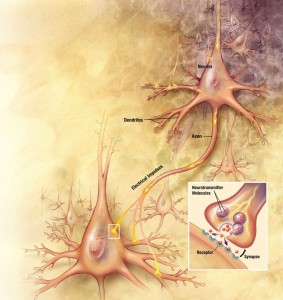 With subjective experience new cells are incorporated into the brain and new circuits are created, altered, strengthened or weakened. The static view of the brain has been disproven and it is now known that the brain is very active—constantly changing connections and growing circuits, thought-by-thought, minute-by-minute and day-by-day. Many different brain mechanisms alter neuronal connections—in large networks, not just in individual synapses. In fact, the larger the brain circuit involved in the neuroplasticity, the better the learning and the more powerful the experience. This neuroplasticity primer and update includes important examples of mental events changing brain circuits.
With subjective experience new cells are incorporated into the brain and new circuits are created, altered, strengthened or weakened. The static view of the brain has been disproven and it is now known that the brain is very active—constantly changing connections and growing circuits, thought-by-thought, minute-by-minute and day-by-day. Many different brain mechanisms alter neuronal connections—in large networks, not just in individual synapses. In fact, the larger the brain circuit involved in the neuroplasticity, the better the learning and the more powerful the experience. This neuroplasticity primer and update includes important examples of mental events changing brain circuits.
Enlarging the Neuroplasticity Circuit
 1. Imagine high jumping. Visualizing a successful jump before the event increases success by 35%. But, remarkably, if while imagining the future high jump an arm is moved the success rate increases to 45%.
1. Imagine high jumping. Visualizing a successful jump before the event increases success by 35%. But, remarkably, if while imagining the future high jump an arm is moved the success rate increases to 45%.
How can this be?
Adding a physical movement to the visual thinking circuit makes the strengthened brain circuit larger and more powerful.
 2. While learning arithmetic one group learned the usual way with the teacher speaking and writing and improved 50%. In another study group the teacher pointed at the blackboard to emphasize the teaching and the learning rate improved.
2. While learning arithmetic one group learned the usual way with the teacher speaking and writing and improved 50%. In another study group the teacher pointed at the blackboard to emphasize the teaching and the learning rate improved.
How can this be?
When the physical movement was used the children learned much better, again, because the learning brain circuit included not just the parts of the brain involved in calculations but also enlarged the circuit by involving a physical movement.
 3. In recent research clenching the right hand strengthened the learning in the left-brain for memory of an event or an action. Clenching the left hand increased effects in right brain of later memory recollection. The study included memorizing 72 words and then later recalling them. The study group clenched either the right or left hands before memorizing and recollecting words. The group that significantly improved memory and recall clenched the right fist when memorizing and left fist when recalling.
3. In recent research clenching the right hand strengthened the learning in the left-brain for memory of an event or an action. Clenching the left hand increased effects in right brain of later memory recollection. The study included memorizing 72 words and then later recalling them. The study group clenched either the right or left hands before memorizing and recollecting words. The group that significantly improved memory and recall clenched the right fist when memorizing and left fist when recalling.
How can this occur?
Left prefrontal regions encode memories, and right pre frontal contribute to retrieval. Clenching the opposite fist increases the neuroplastic circuit.
 4. A very recent study showed that while performing a variety of cognitive tests, chewing gum decreased the reaction time to stimuli in a variety of tests. fMRI showed that chewing had increased activation in the anterior cingulate cortex, and the left frontal gyrus in the executive regions and the motor regions.
4. A very recent study showed that while performing a variety of cognitive tests, chewing gum decreased the reaction time to stimuli in a variety of tests. fMRI showed that chewing had increased activation in the anterior cingulate cortex, and the left frontal gyrus in the executive regions and the motor regions.
Why?
This is another example of enlarged circuits, and increased function.
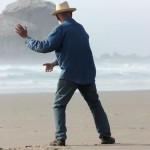 5. In a study of elderly with intractable pain, patients were offered many different modalities of treatment at once from a menu of choices—conventional physical therapy, massage, acupuncture, nutritional counseling, meditation groups, hatha yoga, music therapy, art therapy and counseling. The patients that improved most were those that used more modalities at once. An increase in the neuroplasticity circuit helped their pain.
5. In a study of elderly with intractable pain, patients were offered many different modalities of treatment at once from a menu of choices—conventional physical therapy, massage, acupuncture, nutritional counseling, meditation groups, hatha yoga, music therapy, art therapy and counseling. The patients that improved most were those that used more modalities at once. An increase in the neuroplasticity circuit helped their pain.
In all of these examples neuroplasticity increased because the strengthened circuit was larger.
Everyday Neuroplasticity
When needed the brain changes its function by reorganizing connections, strengthening and weakening synapses through a wide range of mechanisms (see posts How Does Neuroplasticity Work? and New Type of Neuroplasticity).
After two hours blindfolded the brain uses the visual centers to transmit increased touch signals. Eventually entire regions of the brain are rerouted and 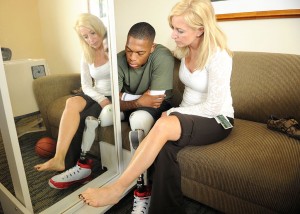 reorganized. Blind people have more accurate memory recall, and have increased hearing ability. The deaf are able to lip-read much better than others.
reorganized. Blind people have more accurate memory recall, and have increased hearing ability. The deaf are able to lip-read much better than others.
New therapies for neuronal damage take advantage of neuroplasticity to bring about positive changes in hearing, vision, movement, and psychiatric symptoms. Visual cues have been used to diminish phantom limb pain. Through mirrors, the brain can be fooled into thinking that the missing limb is still there and can be moved in such a way as to reduce the pain.
 Specific cultural differences trigger unique dramatic effects on brain structure. Island dwellers near Burma live near the sea and learn to swim in deep water to catch clams and find pearls. Through neuroplastic changes in the visual centers of the brain, they have developed the remarkable ability to see clearly under deep water.
Specific cultural differences trigger unique dramatic effects on brain structure. Island dwellers near Burma live near the sea and learn to swim in deep water to catch clams and find pearls. Through neuroplastic changes in the visual centers of the brain, they have developed the remarkable ability to see clearly under deep water.
In martial arts training the power of the black belt is not dependent upon physical strength, but rather unique brain circuits that utilize the muscles in ways that are more powerful and effective.
Increased Brain Connectivity – Multi Sensory and Multi Modalities
Many think the brain evolved in modules (neuronal hubs) where individual senses or movements are predominant. In this view individual modules then send data to associational regions, which integrate senses, feeling, thinking and movement.
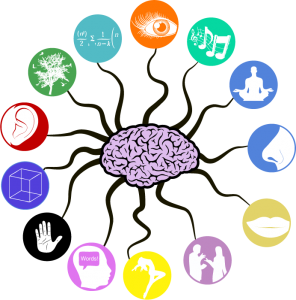 New information reveals that most of the brain is multisensory. The brain regions that analyze individual senses, as well as all of the motor circuits, are highly connected to other regions as well as being highly connected locally. This long-range connectivity of most of the brain hubs makes in even more difficult to find a central place in the brain, which integrates all information for the unified subjective experience. The inherent multi modal and multi sensory nature of the brain means that neuroplasticity occurs more readily in large multi-modal circuits.
New information reveals that most of the brain is multisensory. The brain regions that analyze individual senses, as well as all of the motor circuits, are highly connected to other regions as well as being highly connected locally. This long-range connectivity of most of the brain hubs makes in even more difficult to find a central place in the brain, which integrates all information for the unified subjective experience. The inherent multi modal and multi sensory nature of the brain means that neuroplasticity occurs more readily in large multi-modal circuits.
Between 10% to 50% of the neurons, in supposedly single sensory regions, have neurons that are receiving inputs from multiple sensory modalities at once. Recent MRI studies have shown multisensory regions in all small lobules of the cortex. This is in direct conflict with the accepted notion of brain structure
There are many examples of the way the brain uses multiple senses rather than one.
- Smells, sights and sounds can change the taste of a food. If an orange drink is colored red people think it tastes like cherry.
- Hearing speech usually involves visually observing the lips of speakers. In fact speech is ascertained in the brain by hearing centers, visual centers, and touch. When Helen Keller touched peoples lips, cheeks and necks she could understand their speech in the same language centers by touch.
- Other examples include taste altered by sounds, and posture influenced by vision. If someone is observing a waterfall and has their hand on a table, there is a sensation that the table is moving upward.
When multiple brain modalities are used there is greater neuroplasticity and greater learning.
- If the learning or perception testing is done on an emphasized beat, the learning or perception is much greater than on the other beats, or without rhythm.
- Training of melodic singing is increased if using hand motions as well.
Many Mechanisms of Neuroplasticity
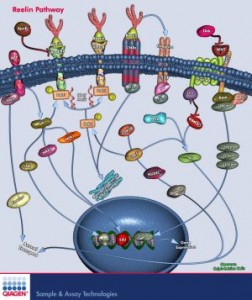 Neuroplasticity occurs because mental events—thinking, seeing, and learning—are connected with molecular changes in brain cells that alter genes, and manufacture new proteins for new functions and circuits. These proteins have unique shapes that the cell, somehow, understands. If fact, the cell edits the messengerRNA transcripts specifically to create the new shapes. This process is so complex the best supercomputers cannot predict the shapes of these transcripts, yet when the cell edits the transcripts it knows what the shape will be, and the effect of that particular shape.
Neuroplasticity occurs because mental events—thinking, seeing, and learning—are connected with molecular changes in brain cells that alter genes, and manufacture new proteins for new functions and circuits. These proteins have unique shapes that the cell, somehow, understands. If fact, the cell edits the messengerRNA transcripts specifically to create the new shapes. This process is so complex the best supercomputers cannot predict the shapes of these transcripts, yet when the cell edits the transcripts it knows what the shape will be, and the effect of that particular shape.
Complex synapses are remolded in a wide variety of ways. New receptors are manufactured and moved into the synapse as new neurotransmitters are manufactured. Scaffolding molecules (the LEGO language of the neuron), build and rebuild structures. Electrical activity alters the functions of neuronal circuits. Ionic channels are altered including calcium, potassium and sodium. Micro RNA alters specific neuron functioning. The next post will discuss even newer discoveries of different neuroplasticity mechanisms.
This complex array of mechanisms occurs in a coordinated way simultaneously across huge complex circuits with hundreds or thousands of synapses. This widespread neuroplasticity is called distributed.
Metaplasticity
Metaplasticity occurs when the circuits become specially primed to be even more flexible in creating more cells and more circuits, even with new learning unrelated to the original causes of neuroplasticity. Exercise and music are triggers of metaplasticity–that is, they help other learning. They are uniquely multi modal and multi sensory effecting a large amount of the brain at once and increasing associated learning in many different ways.
 Many studies show exercise has a wide range of positive effects on the brain and increases memory and learning in a window of time after exercise when more new brain cells are minted in the hippocampus. Recently, a study showed that new brain cells from exercise help dampen anxiety even weeks after exercise. Another recent study showed that even in a situation where a mutation made neurons ineffective, after exercise new brain cells became effective and formed new circuits.
Many studies show exercise has a wide range of positive effects on the brain and increases memory and learning in a window of time after exercise when more new brain cells are minted in the hippocampus. Recently, a study showed that new brain cells from exercise help dampen anxiety even weeks after exercise. Another recent study showed that even in a situation where a mutation made neurons ineffective, after exercise new brain cells became effective and formed new circuits.
 Music also utilizes a large amount of the brain at the same time and greatly enhances learning. Examples of this include using the effects of rhythmic music to alleviate severe movement disorders such as Parkinson’s disease. (see post Music and Neuroplasticity).
Music also utilizes a large amount of the brain at the same time and greatly enhances learning. Examples of this include using the effects of rhythmic music to alleviate severe movement disorders such as Parkinson’s disease. (see post Music and Neuroplasticity).
In both cases, the amount of neuroplastic learning is increased not just in the specific tasks but also in other unrelated aspects of learning. Metaplasticity increases many aspects of learning even unrelated to the specific task.
Powerful Experiences
Music events and spiritual practice using multi modal neuroplasticity evoke powerful memories and often life changing experiences.
 Musical events draw from a very wide range of brain regions: Mental associations are drawn from the history of band members, and the personal associations of melody, rhythms, and lyrics. At a live event, reactions to all of the surrounding events and the connections with a wide variety of people all add to the brain circuits. Dancing to the music adds the physical element that also increased learning in the high jumping, gesturing while teaching and the clenched fists examples above.
Musical events draw from a very wide range of brain regions: Mental associations are drawn from the history of band members, and the personal associations of melody, rhythms, and lyrics. At a live event, reactions to all of the surrounding events and the connections with a wide variety of people all add to the brain circuits. Dancing to the music adds the physical element that also increased learning in the high jumping, gesturing while teaching and the clenched fists examples above.
Spiritual practices, such as meditation, also use broad brain functions, causing strong effects: Meditation practice can include focusing on a mental picture and watching the breath. Listening to sounds, a religious  phrase or mantra adds both musical effects and the associations of meaning. Adding movements in yoga, Tai Chi, or spiritual dances increasing the connection with the physical circuits that were so important in the previous examples. A live religious event, with group meditation, activity, rhythmic chanting, or clapping and movement at a gospel event add even broader brain circuits.
phrase or mantra adds both musical effects and the associations of meaning. Adding movements in yoga, Tai Chi, or spiritual dances increasing the connection with the physical circuits that were so important in the previous examples. A live religious event, with group meditation, activity, rhythmic chanting, or clapping and movement at a gospel event add even broader brain circuits.
Neuroplasticity Primer and Update
Somehow, mental activity is translated into detailed molecular changes in the brain that remodel circuits in multiple places at once. There does not appear to be a central place in the brain to direct this process, but it does occur in connection with subjective mental experience. This lack of any central mechanism makes it appear more likely that mind and brain work together on this process. Recent research is consistent with all-important neuronal hubs being widely connected, not just a computer-like module that is locally connected with some connections to other regions. Most of the brain appears to be multi modal and multi sensory.
In fact, individual neurons somehow know to be part of one circuit at one moment and then a different one at a different moment.
Recent studies also show that most brain activity includes a large number of regions, not the simple regions often described in fMRI studies. Unfortunately, fMRI works at the level of seconds with voxels (the dot of light on the MRI picture – equivalent to a pixel in a computer picture) including 20,000 neurons at a time, where real time brain events occur in very wide ranging regions in the realm of milliseconds often with single neurons. (see post on the Search for the Neural Code).
The connection of mental activity and the brain occurring in wide circuits implies global direction from the mental activity. The same problem of finding the center that binds activity together occurs in understanding subjective experience, direction of cellular DNA and RNA editing, and the immense regulation of the genome.
In all of these cases we must ask whether mind is somehow directing these molecular processes. The next post will discuss recent newly discovered mechanisms of neuroplasticity.